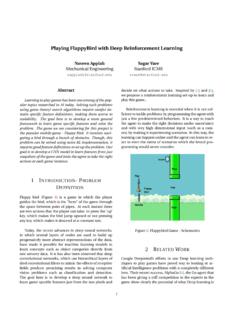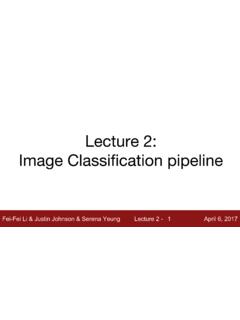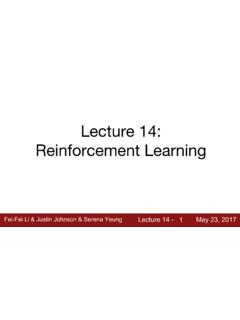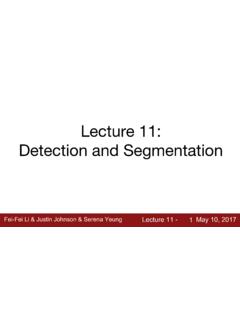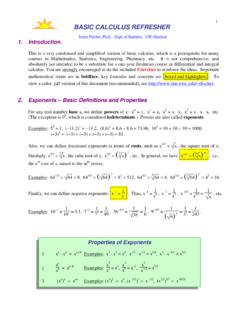Transcription of Vector, Matrix, and Tensor Derivatives
1 Vector, Matrix, and Tensor DerivativesErik learned -MillerThe purpose of this document is to help you learn to take Derivatives of vectors, matrices,and higher order tensors (arrays with three dimensions or more), and to help you takederivativeswith respect tovectors, matrices, and higher order Simplify, simplify, simplifyMuch of the confusion in taking Derivatives involving arrays stems from trying to do toomany things at once. These things include taking Derivatives of multiple componentssimultaneously, taking Derivatives in the presence of summation notation, and applying thechain rule.
2 By doing all of these things at the same time, we are more likely to make errors,at least until we have a lot of Expanding notation into explicit sums and equations for eachcomponentIn order to simplify a given calculation, it is often useful to write out the explicit formula fora single scalar elementof the output in terms of nothing butscalar variables. Once one hasan explicit formula for a single scalar element of the output in terms of other scalar values,then one can use the calculus that you used as a beginner, which is much easier than tryingto do matrix math, summations, and Derivatives all at the same we have a column vector~yof lengthCthat is calculated by formingthe product of a matrixWthat isCrows byDcolumns with a column vector~xof lengthD:~y=W ~x.
3 (1)Suppose we are interested in the derivative of~ywith respect to~x. A full characterizationof this derivative requires the (partial) Derivatives of each component of~ywith respect to eachcomponent of~x, which in this case will containC Dvalues since there areCcomponentsin~yandDcomponents of~ s start by computing one of these, say, the 3rd component of~ywith respect to the7th component of~x. That is, we want to compute ~y3 ~x7,1which is just the derivative of one scalar with respect to first thing to do is to write down the formula for computing~y3so we can take itsderivative.
4 From the definition of matrix-vector multiplication, the value~y3is computed bytaking the dot product between the 3rd row ofWand the vector~x:~y3=D j=1W3,j~xj.(2)At this point, we have reduced the original matrix equation (Equation 1) to a scalar makes it much easier to compute the desired Removing summation notationWhile it is certainly possible to compute Derivatives directly from Equation 2, people fre-quently make errors when differentiating expressions that contain summation notation ( )or product notation ( ). When you re beginning, it is sometimes useful to write out acomputation without any summation notation to make sure you re doing everything 1 as the first index, we have :~y3=W3,1~x1+W3,2~x2+.
5 +W3,7~x7+..+W3,D~ course, I have explicitly included the term that involves~x7, since that is what we aredifferenting with respect to. At this point, we can see that the expression fory3only dependsupon~x7through a single term,W3,7~x7. Since none of the other terms in the summationinclude~x7, their Derivatives with respect to~x7are all 0. Thus, we have ~y3 ~x7= ~x7[W3,1~x1+W3,2~x2+..+W3,7~x7+..+W3,D~x D](3)= 0 + 0 +..+ ~x7[W3,7~x7] +..+ 0(4)= ~x7[W3,7~x7](5)=W3,7.(6)By focusing on one component of~yand one component of~x, we have made the calculationabout as simple as it can be.
6 In the future, when you are confused, it can help to try toreduce a problem to this most basic setting to see where you are going Completing the derivative: the Jacobian matrixRecall that our original goal was to compute the Derivatives of each component of~ywithrespect to each component of~x, and we noted that there would beC Dof these. They2can be written out as a matrix in the following form: ~y1 ~x1 ~y1 ~x2 ~y1 ~x3.. ~y1 ~xD ~y2 ~x1 ~y2 ~x2 ~y2 ~x3.. ~y2 ~ ~yC ~x1 ~yC ~x2 ~yC ~x3.. ~yC ~xD In this particular case, this is called theJacobian matrix, but this terminology is not tooimportant for our that for the equation~y=W ~x,the partial of~y3with respect to~x7was simply given byW3,7.
7 If you go through the sameprocess for other components, you will find that, for alliandj, ~yi ~xj=Wi, means that the matrix of partial Derivatives is ~y1 ~x1 ~y1 ~x2 ~y1 ~x3.. ~y1 ~xD ~y2 ~x1 ~y2 ~x2 ~y2 ~x3.. ~y2 ~ ~yC ~x1 ~yC ~x2 ~yC ~x3.. ~yC ~xD = W1,1W1,2W1,3.. W1,DW2,1W2,2W2,3.. W2, ,1WC,2WC,3.. WC,D. This, of course, is , after all this work, we have concluded that for~y=W ~x,we haved~yd~x= Row vectors instead of column vectorsIt is important in working with different neural networks packages to pay close attention tothe arrangement of weight matrices, data matrices, and so on.
8 For example, if a data matrixXcontains many different vectors, each of which represents an input, is each data vector arow or column of the data matrixX?In the example from the first section, we worked with a vector~xthat was a columnvector. However, you should also be able to use the same basic ideas when~xis a row Example 2 Let~ybe arow vectorwithCcomponents computed by taking the product of another rowvector~xwithDcomponents and a matrixWthat isDrows byCcolumns.~y=~ , despite the fact that~yand~xhave the same number of components as before,the shape ofWis thetransposeof the shape that we used before forW.
9 In particular, sincewe are now left-multiplying by~x, whereas before~xwas on the right,Wmust be transposedfor the matrix algebra to this case, you will see, by writing~y3=D j=1~xjWj,3that ~y3 ~x7=W7, that the indexing intoWis the opposite from what it was in the first , when we assemble the full Jacobian matrix, we can still see that in this case aswell,d~yd~x=W.(7)3 Dealing with more than two dimensionsLet s consider another closely related problem, that of computingd~ this case,~yvaries along one coordinate whileWvaries along two coordinates.
10 Thus, theentire derivative is most naturally contained in athree-dimensional array. We avoid the term three-dimensional matrix since it is not clear how matrix multiplication and other matrixoperations are defined on a three-dimensional with three-dimensional arrays, it becomes perhaps more trouble than it s worthto try to find a way to display them. Instead, we should simply define our results as formulaswhich can be used to compute the result on any element of the desired three s again compute a scalar derivative between one component of~y, say~y3and onecomponent ofW, sayW7,8.
